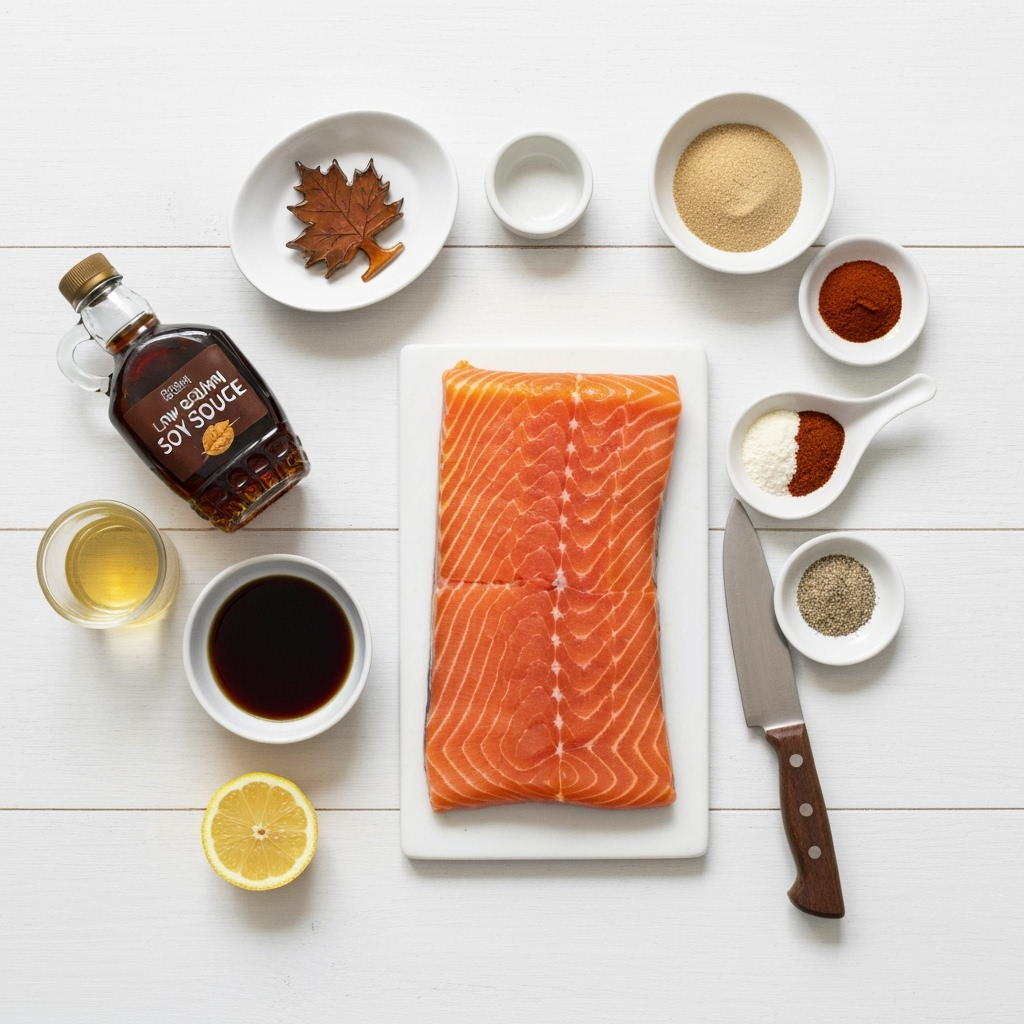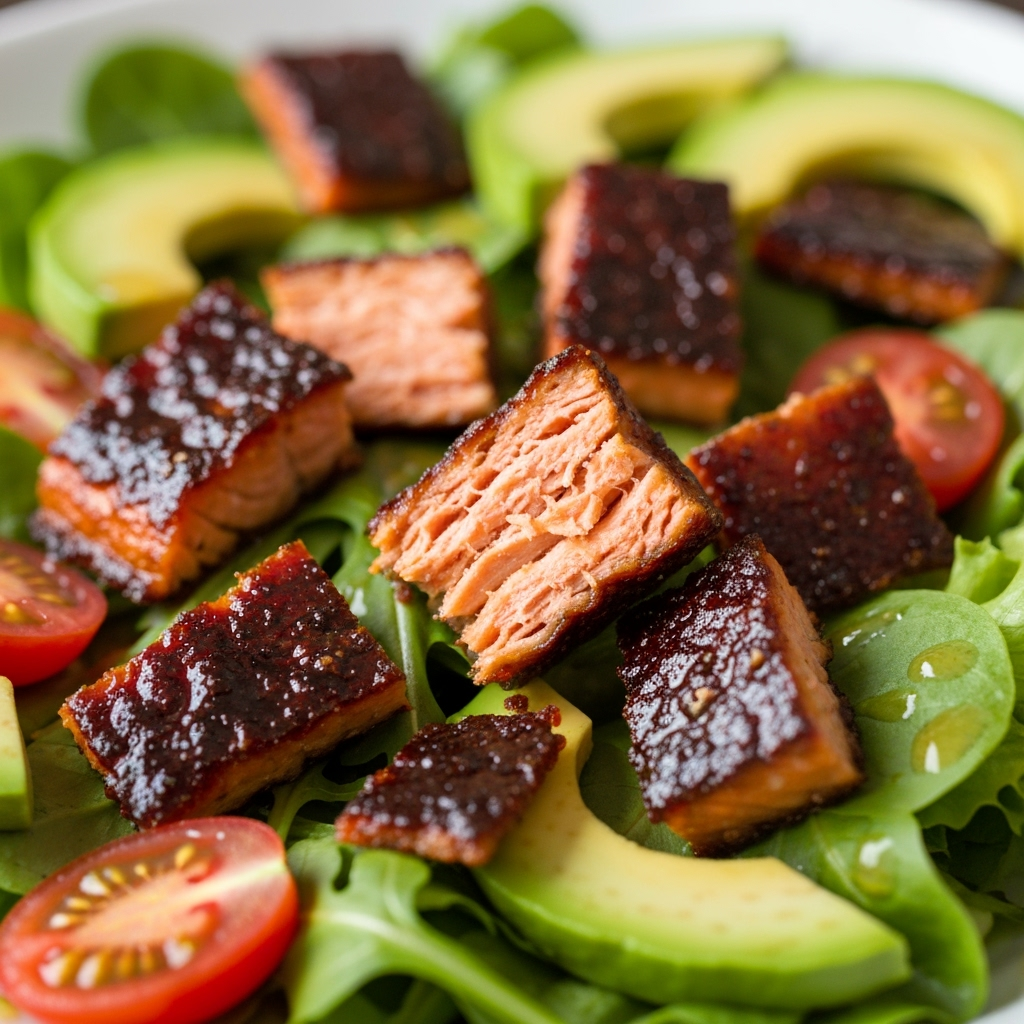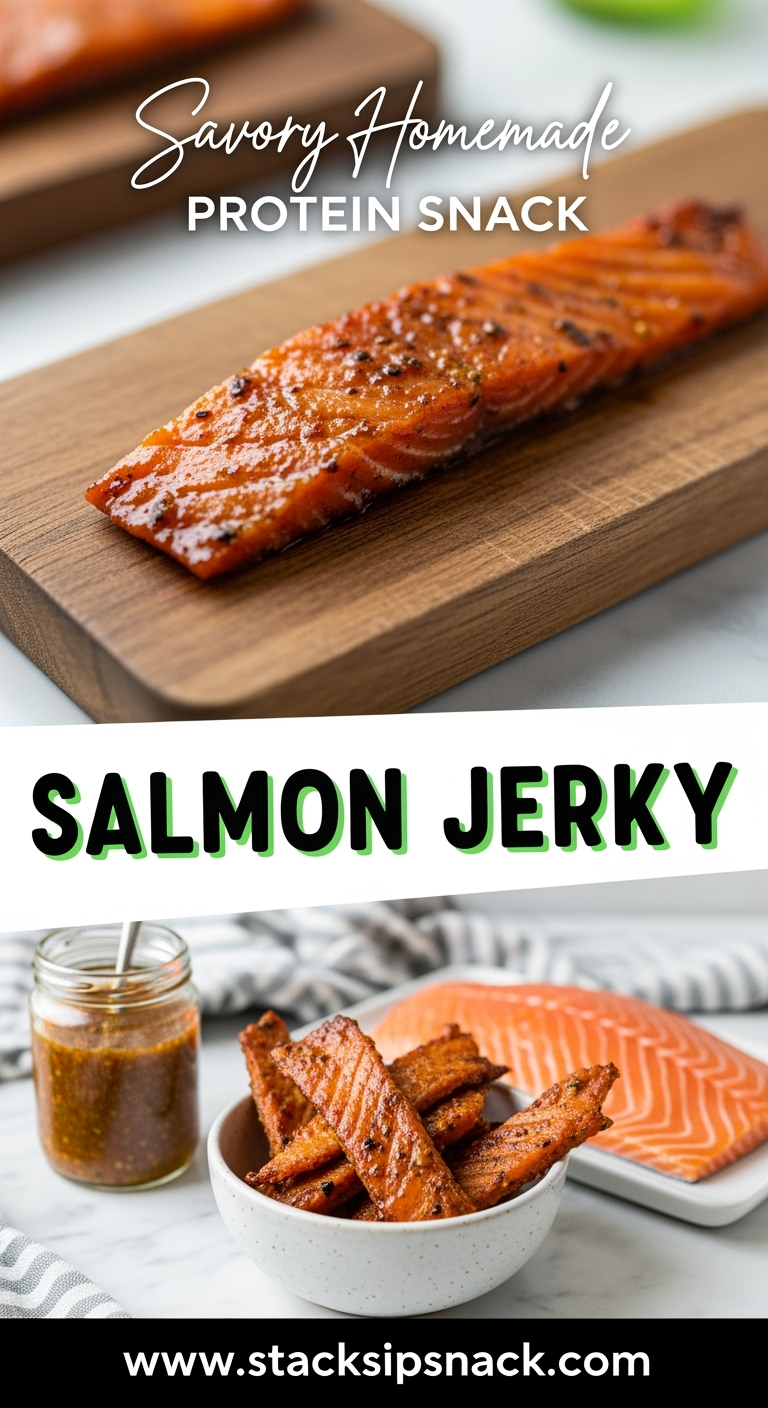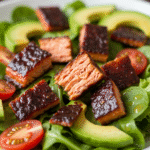There’s something deeply satisfying about making your own snacks from scratch. I remember the first time I tried salmon jerky—it was on a hiking trip with friends, and one of them pulled out a homemade batch. The flavor was incredible: smoky, savory, and packed with protein that kept us energized for hours. Store-bought versions can be pricey and often loaded with preservatives, but when you make it yourself, you control the ingredients and the flavor. That’s why I’m so excited to share this easy, foolproof method for creating your own salmon jerky right at home.
If you’ve ever made beef jerky before, you’ll find the process familiar, but the result is uniquely tender and rich. Salmon jerky is a fantastic high-protein snack that’s perfect for busy weekdays, post-workout fuel, or outdoor adventures. Plus, it’s naturally low in carbs, making it a great option for keto diets. Whether you’re a jerky-making novice or a seasoned pro, this recipe will guide you through each step with confidence.
Ready to get started? Let’s dive into the world of homemade salmon jerky.
Table of Contents
Salmon Jerky Ingredients

Salmon jerky starts with a handful of simple, flavorful ingredients. Here’s what you’ll need:
- 1 lb fresh salmon fillet (skinless, preferably center-cut)
- ¼ cup soy sauce (or tamari for gluten-free)
- 2 tbsp maple syrup or honey
- 1 tbsp olive oil
- 1 tsp smoked paprika
- 1 tsp garlic powder
- ½ tsp black pepper
- ¼ tsp cayenne pepper (optional, for a little heat)
Ingredient Notes & Swaps:
- For a teriyaki salmon jerky twist, replace maple syrup with 2 tbsp brown sugar and add 1 tsp grated ginger.
- If you’re watching sodium, use low-sodium soy sauce or coconut aminos.
- No smoked paprika? Regular paprika works, but you’ll miss that subtle smokiness.
Salmon Jerky Timing
- Prep time: 15 minutes (plus 2–4 hours marinating)
- Cook time: 3–4 hours
- Total time: About 4–5 hours
While the drying process takes a few hours, most of that is hands-off. It’s about 30% faster than some traditional beef jerky recipes because salmon is naturally leaner and thinner.
Step-by-Step Salmon Jerky Instructions
Making salmon jerky is straightforward, but a few key steps ensure perfect results every time.
- Prep the Salmon: Pat the salmon fillet completely dry with paper towels. Slice against the grain into ¼-inch thick strips. Uniform thickness is crucial for even drying.
- Make the Marinade: In a medium bowl, whisk together soy sauce, maple syrup, olive oil, smoked paprika, garlic powder, black pepper, and cayenne (if using).
- Marinate: Place salmon strips in a resealable bag or shallow dish. Pour the marinade over, ensuring each piece is coated. Seal and refrigerate for 2–4 hours. Don’t marinate longer—the acid in the soy sauce can start to “cook” the fish.
- Dry the Salmon: Preheat your oven or dehydrator to 165°F (74°C). Arrange marinated salmon strips in a single layer on a wire rack set over a baking sheet (to allow air circulation). If using a dehydrator, follow manufacturer instructions.
- Cook Low and Slow: Dry for 3–4 hours, flipping halfway through. The jerky is done when it’s firm, dry to the touch, and slightly flexible but not brittle.
Pro Tip: For extra smoky flavor without a smoker, add a drop of liquid smoke to the marinade. If you love our classic beef jerky, you’ll appreciate how salmon’s natural oils keep it tender.
Salmon Jerky Nutritional Information
Per serving (1 oz):
- Calories: 70
- Protein: 9g
- Fat: 3g
- Carbohydrates: 2g
Salmon is rich in omega-3 fatty acids, which support heart and brain health. This homemade salmon jerky is also free from the artificial preservatives found in many store-bought brands, making it a cleaner, high-protein snack.
Equipment Needed for Salmon Jerky
You don’t need fancy gear to make great jerky. Here’s what I use:
- Sharp chef’s knife (for even slicing)
- Mixing bowls
- Baking sheet + wire rack (for oven method)
- Dehydrator (optional but efficient)
If you’re new to jerky-making, check out our deer jerky recipe for more tips on using a dehydrator.
Why You’ll Love This Salmon Jerky Recipe
- It’s Packed with Protein: Each bite delivers a serious protein punch, ideal for fueling your day.
- Customizable Flavors: Adjust the seasonings to match your mood—spicy, sweet, or smoky.
- Perfect for Meal Prep: Make a big batch for the week ahead.
- Healthier Than Store-Bought: You control the salt, sugar, and quality of ingredients.
- Great for Gifting: Homemade jerky makes a thoughtful, delicious present.
Healthier Alternatives for Salmon Jerky

If you’re looking to tweak this recipe for specific diets, here are a few easy swaps:
- Keto Salmon Jerky: Replace maple syrup with a sugar-free alternative like monk fruit syrup.
- Paleo-Friendly: Use coconut aminos instead of soy sauce and raw honey.
- Lower Sodium: Reduce soy sauce by half and add a splash of apple cider vinegar for tang.
For other high-protein snack ideas, our chicken jerky is another lean, delicious option.
Serving Suggestions for Salmon Jerky
Salmon jerky is incredibly versatile. Enjoy it straight from the bag, or get creative:
- Crumble over salads for a protein boost.
- Serve with cheese and crackers as part of a charcuterie board.
- Pack in lunchboxes alongside fresh fruit and nuts.
- Pair with crisp apple slices for a sweet-and-savory snack.
Common Mistakes to Avoid with Salmon Jerky
Even experienced cooks can run into a few hiccups. Here’s what to watch for:
- Slicing Unevenly: If some pieces are thicker than others, they won’t dry at the same rate. Use a sharp knife and take your time.
- Over-Marinating: Fish is delicate. Marinating longer than 4 hours can make the texture mushy.
- Skipping the Wire Rack: Placing salmon directly on a baking sheet steams the jerky instead of drying it. Always use a rack for airflow.
- Over-Drying: Check for doneness starting at the 3-hour mark. Jerky should be chewy, not rock-hard.
Storing Tips for Salmon Jerky
Proper storage keeps your jerky fresh and flavorful:
- Store in an airtight container or resealable bag at room temperature for up to 2 weeks.
- For longer storage, keep in the refrigerator for up to 1 month.
- Freeze for up to 3 months. Thaw at room temperature before enjoying.

Salmon Jerky Conclusion
Making your own salmon jerky is a rewarding process that pays off in flavor, nutrition, and satisfaction. Whether you’re prepping snacks for a hike, looking for a keto-friendly option, or simply exploring new ways to enjoy salmon, this recipe delivers. It’s easier than you think, and the results are far superior to anything you’ll find in a store.
I’d love to hear how your batch turns out! Leave a comment below with your favorite flavor variations or any questions. And if you’re a jerky enthusiast, don’t miss our No Man’s Land beef jerky for another hearty, homemade option.
Happy snacking
FAQs about salmon jerky
Is salmon jerky healthy?
Yes, salmon jerky is a healthy snack option. It is packed with high-quality protein, omega-3 fatty acids for heart and brain health, and essential vitamins like Vitamin D and B12. It is typically lower in fat and calories than beef jerky, making it a nutritious choice for active individuals.
Is salmon jerky fully cooked?
Yes, commercially prepared salmon jerky is fully cooked. The process of making jerky involves curing the fish and then dehydrating it at a low temperature for a long period, which effectively cooks the salmon and makes it safe to eat without further preparation.
How long does salmon jerky last?
When stored properly in a cool, dry place, unopened commercial salmon jerky can last 1-2 years. Once opened, it is best to consume it within 1-2 weeks. For homemade salmon jerky, it should be refrigerated and consumed within 1-2 months for optimal quality and safety.
Can you make salmon jerky at home?
Yes, you can make salmon jerky at home using a food dehydrator or a low-temperature oven. The process involves slicing a salmon fillet thinly, marinating it in a seasoning blend, and then dehydrating it until it reaches a chewy, leathery texture. Proper food safety practices are crucial when making jerky at home.
Is salmon jerky good for dogs?
Salmon jerky made specifically for dogs can be a healthy treat, as it is a great source of protein and omega-3s for a shiny coat. However, you should never feed your dog jerky made for humans, as it often contains high levels of salt, sugar, and spices like garlic and onion that are toxic to dogs.
What does salmon jerky taste like?
Salmon jerky has a distinct, savory, and slightly fishy flavor that is more pronounced than beef jerky. The taste is often enhanced with marinades and seasonings, commonly featuring soy sauce, brown sugar, maple, black pepper, or smoky flavors, resulting in a deliciously salty and umami-rich snack.

salmon jerky
- Total Time: 4 hours
- Yield: 4 servings 1x
- Diet: Gluten Free
Description
Make your own delicious, protein-packed salmon jerky at home with this easy recipe. Perfect for snacks, hiking, or meal prep.
Ingredients
- 1 lb fresh salmon fillet (skinless, preferably center-cut)
- ¼ cup soy sauce (or tamari for gluten-free)
- 2 tbsp maple syrup or honey
- 1 tbsp olive oil
- 1 tsp smoked paprika
- 1 tsp garlic powder
- ½ tsp black pepper
- ¼ tsp cayenne pepper (optional, for a little heat)
Instructions
- Prep the Salmon: Pat the salmon fillet completely dry with paper towels. Slice against the grain into ¼-inch thick strips. Uniform thickness is crucial for even drying.
- Make the Marinade: In a medium bowl, whisk together soy sauce, maple syrup, olive oil, smoked paprika, garlic powder, black pepper, and cayenne (if using).
- Marinate: Place salmon strips in a resealable bag or shallow dish. Pour the marinade over, ensuring each piece is coated. Seal and refrigerate for 2–4 hours. Don’t marinate longer—the acid in the soy sauce can start to cook the fish.
- Dry the Salmon: Preheat your oven or dehydrator to 165°F (74°C). Arrange marinated salmon strips in a single layer on a wire rack set over a baking sheet (to allow air circulation). If using a dehydrator, follow manufacturer instructions.
- Cook Low and Slow: Dry for 3–4 hours, flipping halfway through. The jerky is done when it’s firm, dry to the touch, and slightly flexible but not brittle.
Notes
For extra smoky flavor without a smoker, add a drop of liquid smoke to the marinade. Store in an airtight container at room temperature for up to 2 weeks, in refrigerator for up to 1 month, or freeze for up to 3 months.
- Prep Time: 15 minutes
- Cook Time: 3 hours
- Category: Snack
- Method: Dehydrating
- Cuisine: American
Nutrition
- Serving Size: 1 oz
- Calories: 70
- Sugar: 2g
- Sodium: 320mg
- Fat: 3g
- Saturated Fat: 0.5g
- Unsaturated Fat: 2g
- Trans Fat: 0g
- Carbohydrates: 2g
- Fiber: 0g
- Protein: 9g
- Cholesterol: 20mg
💬 Let’s Stay Connected!
For daily recipes, kitchen tips, and exclusive content, follow me on:
👉 Facebook for behind-the-scenes & community fun
👉 Pinterest for visual inspiration & meal ideas
👉 X (Twitter) for quick tips & trending recipes
📲 Join the flavor journey, your next favorite recipe is just a follow away!










